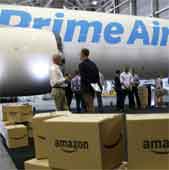| |
|
| |
|
 |
Supply
Chain by the Numbers |
| |
|
| |
- March 4, 2021
|
| |
|
| |
|
| |
|
| |
Amazon Prime Air Adding more Flights; FedEx is Spending Big to get Rid of CO2; Manufacturing Activity Jumps, but with Signs of Inflation; China will not Overtake US Economy? |
| |
|
| |
| |
| |
| |
160 |
 |
That is how many daily cargo flights Amazon Air is likely to fly by this summer, according to a new report from DePaul University of Chicago's Chaddick Institute for Metropolitan Development titled "Primed and Positioned, Strategic Moves by Amazon Air." If that happens, it could make Amazon a potential carrier of business-to-consumer packages outside its own network. The report estimates Amazon Air expanded it flight schedule by 15% between August 2020 and February, adding 18 flights per day. If Amazon does reach 160 flights by June, it will have more than doubled in just 13 months. The report says more Amazon Air expansion is planned, with a focus on its largest hubs. This expansion would also enable Amazon to cover the entire United States. The report notes the Cincinnati-Northern Kentucky hub is especially critical due to the fact cargo can be hauled from the site by truck in fewer than 10 hours to areas in the East Coast, Mid-Atlantic, South and Midwest. However, Amazon's feet of 85 aircraft, after 11 just acquired previously owned Boeing 767-30i0 are put into service, is dwarfed by FexEx's fleet of 680 planes and UPS' 572 aircraft.
|
|
|
| |
| |
|
|
 |
In good economic news, that was the level of the February US Purchasing Index, an increase of 2.1 percentage points from the January reading of 58.7, as released Monday by the Institute for Supply Management. It also means the index was well above the 50 mark that separates US manufacturing expansion from contraction. The strong PMI indicates expansion in the overall economy for the ninth consecutive months after contraction in March, April, and May. In positive news for future manufacturing activity, the ISM New Orders Index was a strong 64.8, up 3.7 percentage points from the January reading of 61.1. That is all to the positive. The growing worry – inflation building in the supply chain. The ISM Prices Paid Index that is released with the PMI came in at an incredibly high level of 86, meaning 86% of ISM survey respondents reported seeing higher input prices. |
| |
| |
|
|
| |
| |
0.5% |
 |
That is the projected annual decline in the Chinese workforce in coming years, a report from Capital Economics said last week, as fewer young people replace a growing number of retirees. In the US by contrast, the workforce is expected to expand through the next 30 years, supported by higher fertility rates than in China and by immigration, virtually non-existent in China. That leads Capital Economics to predict that, contrary to other recent estimates, China will not overtake the US as the world's largest economy in 2028. It said another possible outcome is that China makes it to the top spot in the 2030s, but then falls back again as this demographic drag increases. As a result of all this, China's economy is likely to be just the world's second largest in 2050, still trailing the US. Demography is destiny, as the saying goes. |
| |
| |
| |
| |
| |
|
|
|
| |
 |
 |
| |
 |
![]() |
 |
|
| |
 |
Feedback |
|
|
|
![]()
|
No Feedback on this article yet.
|
|
![]() |
|
|
|
![]() |
 |
![]() |
 |
|
| |